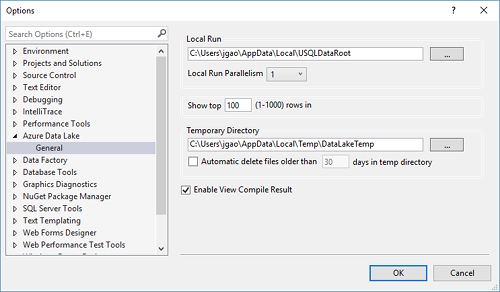| title | description | services | ms.service | author | ms.author | manager | editor | ms.assetid | ms.topic | ms.date |
|---|---|---|---|---|---|---|---|---|---|---|
Run U-SQL scripts locally using the Azure Data Lake U-SQL SDK |
This article describes how to use Azure Data Lake Tools for Visual Studio to test and debug U-SQL jobs on your local workstation. |
data-lake-analytics |
data-lake-analytics |
mumian |
yanacai |
kfile |
jasonwhowell |
66dd58b1-0b28-46d1-aaae-43ee2739ae0a |
conceptual |
11/15/2016 |
Instead of running U-SQL in Azure, you can run U-SQL on your own box. This is called "local run" or "local execution".
U-SQL Local Run is avaialble in these tools:
- Azure Data Lake Tools for Visual Studio
- Azure Data Lake U-SQL SDK
Both local run and the U-SQL SDK require a data-root folder. The data-root folder is a "local store" for the local compute account. It's equivalent to the Azure Data Lake Store account of a Data Lake Analytics account. Switching to a different data-root folder is just like switching to a different store account. If you want to access commonly shared data with different data-root folders, you must use absolute paths in your scripts. Or, create file system symbolic links (for example, mklink on NTFS) under the data-root folder to point to the shared data.
The data-root folder is used to:
- Store metadata, including databases, tables, table-valued functions (TVFs), and assemblies.
- Look up the input and output paths that are defined as relative paths in U-SQL. Using relative paths makes it easier to deploy your U-SQL projects to Azure.
You can use both a relative path and a local absolute path in U-SQL scripts. The relative path is relative to the specified data-root folder path. We recommend that you use "/" as the path separator to make your scripts compatible with the server side. Here are some examples of relative paths and their equivalent absolute paths. In these examples, C:\LocalRunDataRoot is the data-root folder.
| Relative path | Absolute path |
|---|---|
| /abc/def/input.csv | C:\LocalRunDataRoot\abc\def\input.csv |
| abc/def/input.csv | C:\LocalRunDataRoot\abc\def\input.csv |
| D:/abc/def/input.csv | D:\abc\def\input.csv |
Data Lake Tools for Visual Studio provides a U-SQL local-run experience in Visual Studio. By using this feature, you can:
-
Run a U-SQL script locally, along with C# assemblies.
-
Debug a C# assembly locally.
-
Create, view, and delete U-SQL catalogs (local databases, assemblies, schemas, and tables) from Server Explorer. You can also find the local catalog also from Server Explorer.
The Data Lake Tools installer creates a C:\LocalRunRoot folder to be used as the default data-root folder. The default local-run parallelism is 1.
-
Open Visual Studio.
-
Open Server Explorer.
-
Expand Azure > Data Lake Analytics.
-
Click the Data Lake menu, and then click Options and Settings.
-
In the left tree, expand Azure Data Lake, and then expand General.
A Visual Studio U-SQL project is required for performing local run. This part is different from running U-SQL scripts from Azure.
-
From Visual Studio, open your U-SQL project.
-
Right-click a U-SQL script in Solution Explorer, and then click Submit Script.
-
Select (Local) as the Analytics account to run your script locally. You can also click the (Local) account on the top of script window, and then click Submit (or use the Ctrl + F5 keyboard shortcut).
You can debug C# assemblies without submitting and registering it to Azure Data Lake Analytics Service. You can set breakpoints in both the code behind file and in a referenced C# project.
- Set breakpoints in the code behind file.
- Press F5 to debug the script locally.
Note
The following procedure only works in Visual Studio 2015. In older Visual Studio you may need to manually add the pdb files.
-
Create a C# Assembly project, and build it to generate the output dll.
-
Register the dll using a U-SQL statement:
CREATE ASSEMBLY assemblyname FROM @"..\..\path\to\output\.dll"; -
Set breakpoints in the C# code.
-
Press F5 to debug the script with referencing the C# dll locally.
In addition to running U-SQL scripts locally by using Visual Studio, you can use the Azure Data Lake U-SQL SDK to run U-SQL scripts locally with command-line and programming interfaces. Through these, you can scale your U-SQL local test.
Learn more about Azure Data Lake U-SQL SDK.
- To see a more complex query, see Analyze website logs using Azure Data Lake Analytics.
- To view job details, see Use Job Browser and Job View for Azure Data Lake Analytics jobs.
- To use the vertex execution view, see Use the Vertex Execution View in Data Lake Tools for Visual Studio.


